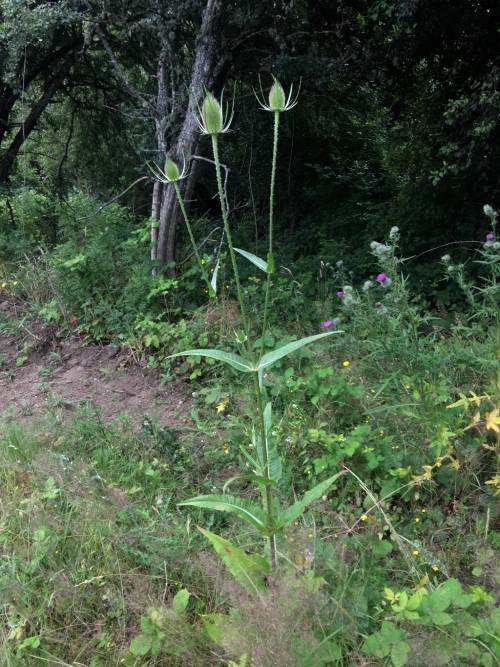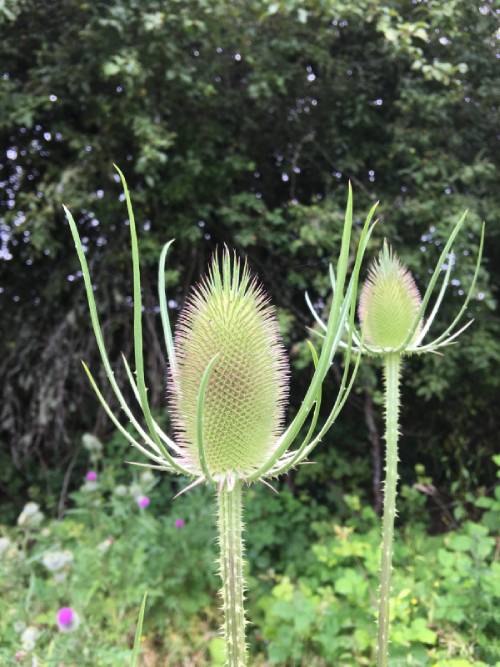Common teasel identification and control
Information about the noxious, weed common teasel. Common teasel is also known by its Latin name, Dipsacus fullonum.
About this weed
Common teasel is a non-regulated Class C noxious weed. This means due to how widespread it is, property owners are not required to control this species on their property, though it is encouraged.
Common teasel is known as Dipsacus fullonum and it is in the honeysuckle family.

Why it’s a problem
Teasel can create large, dense stands and is a highly competitive plant in open, grassy habitats. Common teasel has a negative impact on pastureland, hay fields and other agricultural fields. Teasel can overwhelm native grassland species.
Plant description
Originally from Europe and northern Africa, common teasel was first introduced to North America in the 1700's and has since spread from coast to coast. Most often seen on roadsides and waste areas, teasel also invades agricultural fields and pastures. It is often spread by the practice of mowing standing plants after they have formed seeds.
Common teasel is a tall, somewhat spiny, short-lived perennial (plants that have a 2 or more years life cycle) or biennial (2-year life cycle) that dies after it goes to seed. The distinctive seed heads are popular in floral arrangements.
Common teasel grows for one or more years as a low-growing rosette (a circular cluster of leaves on ground level), then produces tall stems topped by flower heads.
Flowering stems are prickly and can be from 1.5 to 6.5 feet tall. They are ridged and become increasingly prickly higher up.
Stems can be pithy or hollow and have opposite branching.
The leaf arrangement is mostly opposite, and the toothed leaves are much longer than wide, and widest below the middle (lanceolate shaped).
Common teasel flowers are light purple to white and tend to grow in bands or rings on large, egg-shaped, spiny heads.
The cone-like flower heads can be up to 4 inches tall, occur singly on the tops of stems, and are persistent long after the seeds form.
Under the flower heads are long, narrow, prickly flower parts that curve upward and form a "cage" around the heads.






Be aware of look-alike plants
Common teasel is often confused with:
When in doubt, take photos and report them on iNaturalist.
What to do if you find it
Because common teasel is so widespread, property owners in King County are not required to control it. We are not generally tracking infestations. We can provide advice on how to control common teasel, but there is generally no legal requirement to do so.
The King County Noxious Weed Control Board encourages property owners to remove common teasel where possible, and to avoid introducing it to new landscapes.
Control methods
We recommend using a combination of methods to control weeds. In areas with few weeds, it is important to act quickly before they become harder to control. Make a long-term plan as it often takes several years to get rid of most weeds. Start in the least infested areas first and then move into more heavily infested areas.
Fortunately, teasel is not that difficult to control, especially if you can catch it while the population is small.
Chemical control
Stay safe when using herbicide:
- Always read the label before use.
- Wear a long-sleeved shirt, long pants, shoes, and eye protection.
- Follow state and local regulations.
Several herbicides have been shown to work on rosettes and pre-flowering plants. See the PNW Pest Management Handbook for the most up to date and specific method for chemical control of common teasel.
Mechanical control
Mechanical control is also effective if done correctly. Once the flowering stalks form, wait until the flowers start to appear and then cut the plants at or right below ground level with a machete or sharp shovel. Cut off all flowers from the stems and dispose in the trash, as they can still set seed after being pulled.
Mowing is not as effective but can be successful if done correctly.
Plants can re-grow from the root-crown if they are cut too high.
Knocked over plants will probably re-grow and set seed.
Clean off equipment before leaving site to avoid further spread.
If garden related, you can consult your local master gardener group or try the Garden Hotline for tips and tricks on managing garden weeds.
Disposal instructions
Remove the flower heads and dispose of them because immature heads have been known to set seed if they are left on the ground. Dead plants can be mulched on site.
Noxious Weed Disposal - Washington State Noxious Weed Control Board

 Translate
Translate